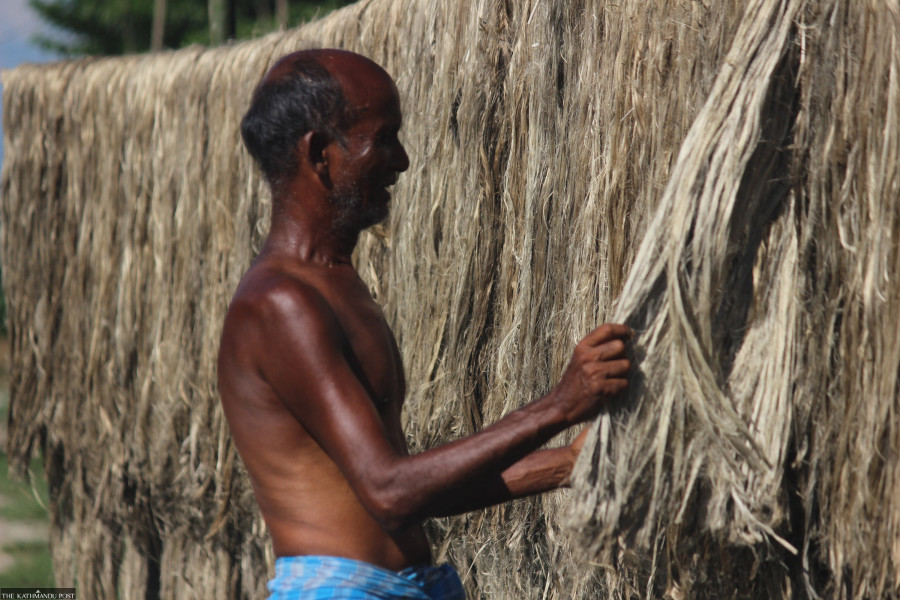Money
Jhapa jute farmers stare at an uncertain future as crop productivity falls
Three decades ago, the country used to be a major exporter of jute to Europe, and the golden fibre was one of the major sources of foreign exchange.
Parbat Portel
Famer Grahan Lal Gangai of Gauriganj rural municipality in eastern Nepal does not regret that he is gradually quitting jute farming despite huge demand for the golden fibre.
A few years ago, he used to cultivate jute on 20 bighas of land and produced around 2,400 kg of raw jute which he used to export to India. The situation has changed now. He has switched primarily to paddy farming but still produces a little jute.
Even though there is high demand for raw jute in the country, the area and production of raw jute have decreased. Jute farmers like Gangai are staring at an uncertain future owing to the low productivity and market.
“I still cultivate jute but only on 1 bigha of land now. It’s difficult to cultivate and it is even difficult to find a market,” said Gangai.
Jute cultivation in the Jhapa district was once a major cash crop for farmers due to huge demand in India. But now, Nepal imports raw jute and its goods from India and Bangladesh.
Farmers in Jhapa started to quit jute farming due to the higher cost of production and low return compared to other crops. According to Krishi Gyan Kendra, a former district agriculture officer, jute production has plunged to a record low in the last few years. “It’s because the rate of return is very low,” said Saligram Bhattarai, an agro technician. “Due to the price risk, farmers don’t seem interested in continuing farming jute.”
A drop in jute output in Nepal, India and Bangladesh has sent prices soaring, hurting Nepali factories that manufacture bags and other products from the golden fibre. The price of raw jute has jumped by 50 percent to Rs90 per kg, jute traders said.
Nepali factories consume 70,000 tonnes of raw jute annually. Nearly 30 percent of the raw jute requirement is met by domestic production while the rest is imported from India and Bangladesh.
Demand for jute bags swells during the festive season, mostly from sugar mills.
Three decades ago, the country used to be a major exporter of jute to Europe, and the golden fibre was one of the major sources of foreign exchange.
Moreover, the industry has been dropped from the government’s priority list even though the demand for more ecological packaging globally has strengthened its export potential.
Until two decades ago, Nepal used to export raw jute to India. Now it's the other way around with the domestic jute industry importing raw jute and exporting 90 percent of its finished goods to India.
The government gives a 3 percent cash subsidy to exporters of jute goods. Nearly a decade ago, 11 jute factories employed more than 40,000 people.
According to industry insiders, more than 20,000 people lost their jobs when six mills were shut down due to a shortage of raw jute, export hassles and lack of electricity.
The land under jute cultivation has also been decreasing. According to Kendra, five years ago, the jute cultivation area in Jhapa was 700 hectares, which now has decreased to 550 hectares.
The southern part of the Jhapa district like Kachankawal, Bhadrapur, Gauriganj, Jhapa and Haldibari were the pocket areas for jute farming. Although the government has established a jute promotion centre, it has become ineffective in encouraging farmers.
According to Mechi Customs Office, in 2019-20, Nepal imported 28,783 tonnes of raw jute worth Rs2.26 billion from India and Bangladesh.
In 2020-21, the import was 26,769 tonnes worth Rs2.83 billion. “The government has waived customs tax on the import of jute to encourage the production of eco-friendly bags made of jute,” said Dhurba Raj Bishwokarma, chief customs officer.
“Although the demand for jute is high in the industrial areas, farmers don’t get a reasonable rate and as a result, they are not attracted to jute farming anymore,” said Nitya Kumar Tajpuria, a farmer of Korobari. “We toil hard to produce jute, but the productivity is low,” he said. He used to cultivate jute on 10 kattha of land until two years ago. “Now, I produce to meet my household use only.”




 11.12°C Kathmandu
11.12°C Kathmandu













%20(1).jpg&w=300&height=200)
